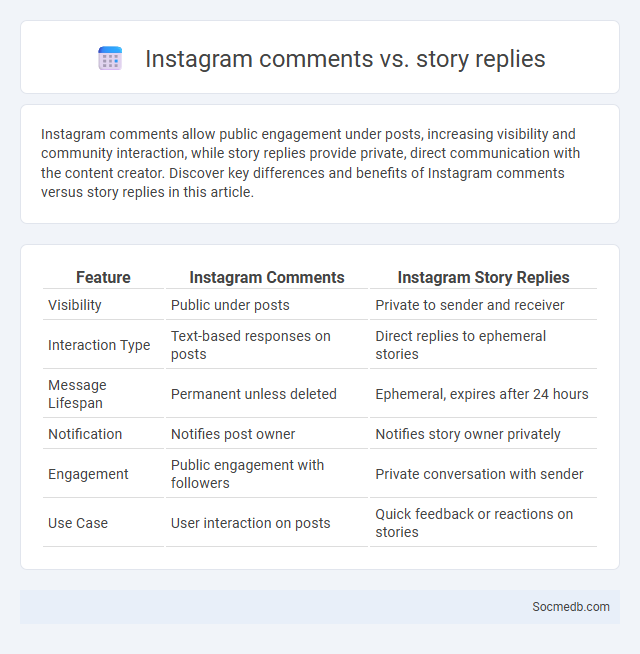
Photo illustration: Instagram Comments vs Story Replies
Instagram comments allow public engagement under posts, increasing visibility and community interaction, while story replies provide private, direct communication with the content creator. Discover key differences and benefits of Instagram comments versus story replies in this article.
Table of Comparison
| Feature | Instagram Comments | Instagram Story Replies |
|---|---|---|
| Visibility | Public under posts | Private to sender and receiver |
| Interaction Type | Text-based responses on posts | Direct replies to ephemeral stories |
| Message Lifespan | Permanent unless deleted | Ephemeral, expires after 24 hours |
| Notification | Notifies post owner | Notifies story owner privately |
| Engagement | Public engagement with followers | Private conversation with sender |
| Use Case | User interaction on posts | Quick feedback or reactions on stories |
Overview of Instagram Comments, Story Replies, and Comment Features
Instagram comments enable users to engage directly with posts by sharing thoughts, questions, or feedback, fostering community interaction. Story replies offer a unique way to respond privately to ephemeral content, enhancing personal connection between you and the creator. Comment features, such as threaded replies, emoji reactions, and moderation tools, optimize user experience by promoting meaningful conversations and maintaining a safe environment.
Key Differences Between Comments and Story Replies
Comments on social media are public or semi-public responses visible to all users under a post, allowing for broader interaction and engagement across the platform. Story replies are private messages sent directly to the content creator, facilitating more personal and immediate communication. Comments often contribute to the public conversation, while story replies enable one-on-one interactions, impacting how social media users engage with content and creators.
Engagement Levels: Comments vs Story Replies
Engagement levels on social media vary significantly between comments and story replies, with comments often demonstrating higher visibility and permanence on posts compared to the fleeting nature of story replies. Your brand can leverage comments to foster public conversations and community building, while story replies offer a more personal, direct line to your audience for quick feedback and interaction. Understanding this distinction allows you to tailor your content strategy for maximizing user interaction and meaningful communication.
Visibility and Reach: Which Gets More Attention?
Visibility on social media depends on factors like algorithm preferences and content quality, directly influencing your brand's exposure to target audiences. Reach measures the total number of unique users who see your content, while visibility captures how prominently that content appears in feeds and searches. To maximize attention, focus on creating engaging posts that boost both visibility and reach, ensuring your message connects with more potential followers.
Algorithm Impact: Comments vs Story Replies
Social media algorithms prioritize user engagement metrics such as comments and story replies to determine content visibility and reach. Comments often contribute more significantly to content ranking because they indicate active user interaction and longer-lasting engagement compared to fleeting story replies. Optimizing for comments can enhance organic reach and foster deeper audience connection within platforms like Instagram and Facebook.
User Intent: Why People Comment or Reply
People comment or reply on social media to express opinions, seek clarification, or engage in meaningful conversations that align with their interests and emotions. Your interactions often aim to build connections, share experiences, or influence discussions within your online community. Understanding user intent behind these actions helps optimize content for better engagement and relevance.
Community Building: Comment Sections vs Stories
Comment sections create a space for your audience to engage in meaningful conversations, fostering a strong and interactive community around your brand. Stories provide a more ephemeral and personal way to connect, encouraging real-time interaction and immediate feedback from followers. Both tools complement each other in building a loyal community by balancing depth of discussion with casual, authentic engagement.
Brand Interaction: Best Practices for Each Format
Effective brand interaction varies across social media platforms, with tailored strategies enhancing engagement and loyalty. On Instagram, utilizing high-quality visuals and interactive Stories encourages real-time audience participation, while Twitter benefits from concise, timely updates and hashtag campaigns to foster conversations. Facebook's strength lies in community building through group interactions and live events, making personalized responses and regular content updates crucial for maintaining brand presence.
Measuring Success: Metrics for Comments and Story Replies
Tracking engagement metrics such as the number of comments and story replies provides valuable insights into audience interaction and content relevance. Monitoring the sentiment and quality of comments helps assess community engagement and brand perception. By analyzing these metrics, you can refine your social media strategy to better resonate with Your audience and increase overall effectiveness.
Choosing the Right Engagement Tool for Your Goals
Selecting the right social media engagement tool depends on your specific goals, whether increasing brand awareness, boosting customer interaction, or driving conversions. Tools like Hootsuite offer comprehensive scheduling and monitoring features, while platforms such as Sprout Social emphasize in-depth analytics and audience insights. Evaluating your target audience and engagement objectives ensures choosing a tool that maximizes Your social media impact effectively.
 socmedb.com
socmedb.com